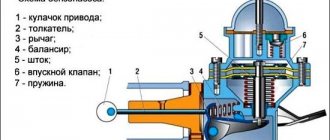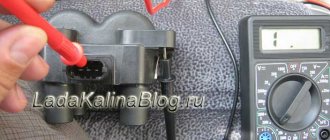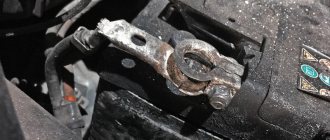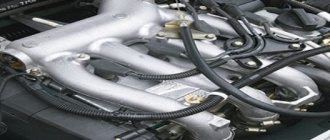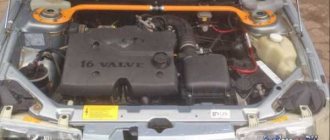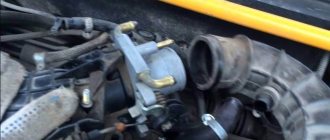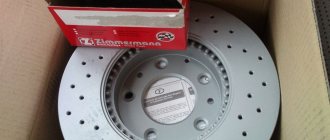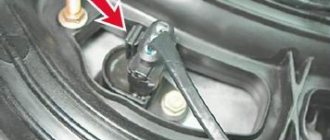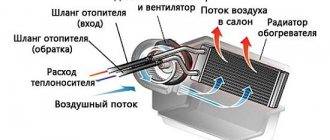Causes of engine overheating
The temperature indicator needle has entered the red zone, which means the engine is overheating
Many car enthusiasts remember the reasons for the effect on old Zhiguli cars. On 16-valve engines, the reasons for this effect are almost the same. Let's consider what reasons may cause the main power unit to begin to overheat:
- The system is clogged.
- Thermostat stuck.
- Damage to the pump. Replace the pump. About choosing a pump for a 16 valve engine here.
- Radiator.
- Cooling sensor malfunction.
- The cooling fan does not operate (see “fan relay).”
All these problems can cause the engine to overheat.
Elimination methods
To eliminate the causes of engine heating, it is necessary to establish the epicenter of the effect. To do this, it is worth checking each node sequentially. After identifying the problem, it is worth finding the exact cause and eliminating it. So, let's consider the sequence of actions.
Engine cooling system diagram
Radiator and pipes
One of the reasons for engine overheating may be that the radiator and pipes become clogged, which affects the circulation of fluid in the system, and can also lead to cracks in the pipes and breakdown of the radiator, which will lead to leakage of coolant.
If there is insufficient coolant in the system, the power unit will heat up faster and take a long time to cool down, and the cooling fan will run almost continuously.
Radiator and cooling system pipes
The method for solving the problem is quite simple - dismantling the radiator from the system and cleaning it both outside and inside.
The second stage will be to inspect the pipes for leaks and replace worn-out products. As practice shows, many motorists install kit kits (tuning versions) of the radiator and pipes to extend the service life of the cooling system.
Pump (water pump)
One of the main reasons for overheating is that there is backlash in the water pump . It is quite easy to determine this malfunction, because a corresponding howl appears in the pump area. Also, a sign of a malfunction may be that liquid begins to leak from the pump shaft. The problem can be fixed quite easily by replacing the water pump.
Engine mounted water pump
Thermostat
The thermostat is the first place to look for a problem.
Every 50 thousand kilometers, it is recommended to change it, but this factor is not all true, since the performance of the part is influenced by factors such as the condition of the coolant, the quality of the installed part, etc.
So, when the thermostat is stuck on a small circle, the engine heats up more often than usual, even when driving on the highway, where there is enough oncoming air flow for the system to have time to cool itself.
Thermostat removed from the engine
There is one caveat when the thermostat should not be changed - if it fails in winter. Then, additional cooling is provided by sub-zero temperatures. Of course, if the thermostat fails in the summer, then to prevent overheating of the motor, it must be replaced as soon as possible.
Cooling sensor
The cooling temperature sensor is a harmless breakdown that can lead to the indicator on the instrument panel showing incorrect data, so the driver will not even know that the engine has overheated until it boils on the road.
Typically, this malfunction is accompanied by many associated factors, so it is quite difficult to miss it. There is only one solution to the problem - replacing the cooling system sensor and resetting errors that occurred in the ECU.
Fan
The last cause of overheating, especially in the summer, is the cooling system fan.
The fan under the hood is indicated by an arrow
So, a breakdown of this unit can cause the engine to overheat and the coolant in the expansion tank to boil.
In this case, the consequences can be very diverse, well, you need to check the fan for serviceability, as well as the sensor for turning it on - that’s for sure. This part fails quite rarely, and therefore the reason for the failure may be a simple fuse or a wiring fault, which can be easily fixed.
Consequences of untimely elimination of defects
Not all drivers realize what consequences can be caused by an engine overheating, and continue to drive with a constantly running fan or frequent overheating.
So, the consequences of strong engine heating are divided into 3 stages, which are worth considering separately.
Slight overheating
If the engine overheats for up to 10 minutes, the consequences may be minor. Thus, cracks will appear in the pipes of the cooling system, the temperature sensor will fail, the oil scraper rings will become deformed, and the valve and camshaft seals will melt. Also, the valves will burn out, and oil will enter the combustion chambers, which will be marked by the release of black smoke from the exhaust system.
Consequences of mild overheating, namely burnout of valves
Significant overheating
With significant overheating, deformation occurs, or rather deflection of the cylinder head. To eliminate these consequences, you will have to dismantle the cylinder head and submit it for surface grinding. Thus, it turns out that the block head is subject to major repairs.
Source: carfrance.ru
Reasons that can cause overheating
- Lack of coolant . The liquid in the engine boils not because there is not enough of it, but here’s why: remember about the outer surface for cooling? If there is a lack of fluid, the contact surface between the fluid and the heated engine is insufficient, and heat transfer to the environment is poor. This is where the overheating comes from. The engine cooling system is not sealed, as many believe, and fluid evaporates during operation - do not forget to check its level regularly. And of course, monitor the condition of the radiator and pipes - leaks are unacceptable. There are cases of internal leakage - as a result of damage to the gasket between the head and the cylinder block. Water will not flow out of the exhaust pipe, but a constant decrease in the fluid level without visible leaks is a reason to be wary and contact a specialist. Water accumulated in the cylinders at the moment of starting the engine can lead to water hammer - this can literally destroy the piston group, and not only that.
- Radiator condition . The gaps between the radiator honeycombs are quite small and can gradually become contaminated by representatives of the insect world. This is not a joke; there was a case when minor contamination of the radiator (coupled with the poor condition of the engine) led to constant overheating of the car. Keep the radiator clean and blow it with compressed air at least occasionally.
- Incorrectly set ignition angle . If the ignition angle is violated, the fuel combustion process is disrupted. As a consequence, an increase in combustion temperature and a decrease in power. The power has dropped, but there is no need. What are we doing? That's right - press the gas pedal harder. It turns out that more fuel is spent on the design operating mode of the engine (at which normal cooling occurs). Hence the overheating. By the way, an ignition problem can arise (spontaneously, and not after your intervention in the finely tuned engine mechanism) if the timing belt or chain is stretched. This is not the only possibility, but it is common - keep in mind.
- Fuel quality . An inappropriate octane number leads to a decrease in power and an increase in the temperature of fuel combustion. There is only one way out - refuel in one place, so the likelihood of getting bad gasoline is lower.
- Deposits on the walls of the engine and radiator . The reason is simple - the use of low-quality coolant, or even water. A little more detail. From a physics point of view, using water is better, since water has better thermal conductivity than alcohol-containing antifreeze. But - there are salts in the water (you can see them on the walls of the kettle) - the same thing happens inside the engine. As a result, water circulation is disrupted, cooling efficiency is reduced and the engine overheats. If you are pouring water into the expansion tank, pour distilled water, it is free of salts. It is best to use special antifreeze. Believe me, it is impossible to completely remove scale from the engine. And one more “beauty of water: if, after water, for example in winter, you fill in antifreeze - be prepared for drips (it can leak anywhere: radiator, pipes) - this is a fact. If you constantly drive “on antifreeze,” nothing will happen, but after water, antifreeze will flow 99%.
- Engine wear . This can include many aspects, but in most cases it is wear of the piston group. During long-term use of the car, the piston rings, which serve to seal the combustion chamber, wear out, which leads to a decrease in compression, impaired fuel combustion, loss of power (remember the formula) and overheating of the car. Somehow it turned out to be too difficult. To put it simply: fuel burns better at a certain pressure that is created in the combustion chamber. Pressure is about 12 atmospheres. If you take a pipe, plug it with potatoes and blow inside, pressure will be created inside, which is called compression. The force with which you blow will represent the force of expansion of the fuel during combustion, which pushes on the piston and causes the crankshaft to rotate. The rings serve to fit the piston more tightly to the cylinder (in our case, potatoes and tube). Now, if you put in a loose piece of potato and blow, the air will pass past the potato piston. This is what happens in the engine when the piston group wears out (ring wear and cylinder wall wear). As a result, part of the expansion energy of the fuel during combustion passes by the piston (between the piston and the cylinder), and compression (optimal pressure in the combustion chamber) decreases, which worsens the quality of combustion. And again - loss of power and overheating. There is only one way out - contact a specialist.
- Radiator fan . In some (older) car models, there was no such reason, since the fan was driven directly from the crankshaft through a belt. Now, the fans are electric and turn on when the temperature sensor is triggered. The sensor may not work, and the fan may not turn on. This is a fairly common reason. You just have to go out and look - the motor connection contacts may be oxidized.
- Air pockets formed when filling liquid. By the way, in this case the temperature sensor may not show an increase in temperature. How to get rid of a traffic jam is the topic of a separate article. I’ll add on my own – when pouring liquid into the cooling system, the car must be horizontal.
- Thermostat . The thermostat divides the cooling system into two circles - small and large. The small one is used to warm up the car (the amount of liquid is reduced, the radiator is turned off), when a certain temperature is reached, the large circle is connected (the radiator is connected). If the thermostat is jammed, then only the small circle is used: the amount of fluid is insufficient, the radiator is turned off - the car is overheating. You can determine this by feeling the lower pipes leading to the radiator: if they are cold and the car is overheated, change the thermostat.
- Water pump . A pump is a pump that forcibly displaces water to improve circulation. By and large, two troubles can happen to the pump: it will simply leak - you will see, and the second, which is more difficult to determine, is wear of the pump impeller. When the impeller wears out, the pump slowly pumps liquid, as a result, the liquid in the engine heats up faster than in the radiator (water circulation worsens). You can tell by uneven heating - the radiator is cold, but the engine is boiling. Attention - the same symptoms occur if the thermostat is malfunctioning or if there is an air lock.
Engine overheating
Coolant overheat alarm
Most cars are equipped with a temperature sensor that measures the operating temperature of the engine. If the overheat warning light comes on while driving (or the temperature gauge goes into the red hot zone), the coolant temperature is between 120°C and 126°C. This temperature still remains below the boiling point of the coolant (provided that the cooling system and the radiator seal are in good condition). If the coolant overheat warning light comes on, do the following:
Step 1. Turn off the interior air conditioning and turn on the interior heater. This will help remove excess heat from the engine faster. Set the fan to maximum rotation speed.
Step 2: If possible, turn off the engine and allow it to cool (this may take more than an hour).
Step 3. Do not under any circumstances attempt to remove the radiator seal until the engine has cooled down.
Step 4: If the overheat warning light is on, do not continue driving, otherwise the engine may be seriously damaged.
Step 5. If the engine does not glow with heat and is not clearly overheated, then the problem may be due to a malfunction of the temperature sensor or temperature indicator. Then you can continue driving, but to be on the safe side, you need to stop from time to time to check for signs of engine overheating and for signs of coolant leakage.
COMMON CAUSES OF ENGINE OVERHEATING
• Low coolant level.
• Clogged, dirty or blocked radiator.
• Faulty fan clutch or faulty electric fan.
• Incorrectly set ignition timing.
• Low oil level in the engine lubrication system.
• Broken fan drive belt.
• Faulty radiator seal.
• Coolant freezing (in frosty weather).
• Faulty water pump of the cooling system (slippage of the impeller on the inner shaft of the pump).
The owner complained that his car's engine overheated, but this only happened when he was driving on the freeway at high speeds. The car was equipped with an engine that worked flawlessly when driving in the city cycle.
The mechanic flushed the cooling system and replaced the radiator seal and water pump, believing that the cause of the overheating was a decrease in coolant flow in the cooling system. During further inspection, it was revealed that when the engine is cranked by the starter with the spark plugs unscrewed, coolant sprays out of one of the cylinders. The problem was resolved after the cylinder head gasket was replaced. Obviously, the leak caused by a defective gasket was not large enough to cause engine malfunction - as long as the speed and load on the engine did not increase so much that the resulting increase in coolant leakage and heat generation did not lead to a rapid increase in temperature.
Common Causes
As you know, the VAZ 2110 is equipped with two types of engines - with 8 and 16 valves. There are several main, most common reasons that cause this overheating of power units.
Let's look at each of the reasons and ways to resolve these problems separately.
Tens engine
Low coolant level
Coolant plays a huge role in the operation of the cooling system. A special substance, namely antifreeze or antifreeze, is poured into the expansion tank.
Related material:
In a normal situation, the level of the coolant solution should be at the level of, or rather the MAX marks on the tank body. This indicates that the container is approximately 50-60 percent full.
If there is no such mark on the tank, refer to the clamp. The liquid should reach its upper edge.
- If the engine overheats, try simply adding the missing amount of coolant so that it is at the optimal filling level.
- If you have not changed the coolant for a long time, it is better not to add new coolant, but simply replace it completely with new coolant.
- When choosing between antifreeze and antifreeze, most VAZ 2110 owners prefer the first. And mainly due to the financial availability of antifreeze. But in practice, antifreeze is better . One of its most important advantages is that the substance does not freeze in severe frosts. For individual regions of our country, this is a key factor in the choice of coolant.
Thermostat
Another reason for engine overheating is a stuck thermostat valve. If it remains in the closed position and does not open, the coolant will move only along a small circuit. As a result, this will lead to strong heating of the power plant. Overheating itself threatens with very, very serious consequences.
Such a malfunction can manifest itself at the most inopportune moment - on the road. You are unlikely to be able to carry out high-quality repairs on the side of the road. But you can try one method - knock on the thermostat housing. Often this allows you to return the device to its functionality for a while. This way you can get to your own garage or the nearest service station. There the thermostat has already been replaced with a new one. There is no point in repairing it. If he failed once, the situation will certainly repeat itself soon.
Related material:
Thermostat in the engine
temperature sensor
A temperature sensor is necessary in order to respond to changes in engine heating. When a preset point is reached, the sensor is triggered and turns on the cooling fan.
If this device malfunctions, the power unit overheats because the fan does not activate. Consequently, the temperature does not fall below critical levels, but continues to gradually rise.
Related material:
If you encounter such a problem on the road (most often the engine overheats while stuck in traffic jams, since the engine is running but there is no flow of cooling oncoming air), try to get out of the jam as quickly as possible and find a free section of the road.
Accelerate during the free stretch and then begin engine braking. This will lower the temperature and prevent overheating. Under no circumstances should you regularly operate your car this way. But this is a great way to get to a garage or auto repair shop, determine the cause of the sensor failure, and then replace it.
Cooling Fan
The symptoms of fan malfunctions are similar to a non-working temperature sensor. That is, the engine will heat up, the indicator on the dashboard will be in the red zone.
Related material:
Again, while on the road, we recommend using the engine braking method. Next, head to the garage. Let the car cool down. In the meantime, go to the store for a new fan. This device for the VAZ 2110 costs about 600 rubles.
Fan problems
Other reasons
There are other equally popular reasons for engine overheating. Therefore, we invite you to familiarize yourself with all of them in our table.
Cause of overheating
Remedy
Coolant level too low
Add coolant to the required level, following the marks or clamp on the expansion tank
The radiator is clogged or blocked
Flush the radiator. If this does not help, the unit must be replaced
The cooling system pump has failed (the impeller slips on its internal shaft)
It's best to replace the pump
The oil level in the lubrication system is critical
Add oil to the required level. If it is old, change the oil
The ignition timing is incorrectly set
Perform torque adjustment
The thermostat has failed
Replace the device with a similar new one
The cooling fan motor has failed
It can be repaired, but it is better to install a new motor
When faced with such a phenomenon as engine overheating, do not rush to send your VAZ 2110 for repair to a car service center. You can find many causes of overheating with your own hands and deal with them yourself. Service station services are not cheap these days, unfortunately.
Source: luxvaz.ru
Why does the engine get very hot?
If you have owned your car for a long time, then you have probably had problems with engine overheating. On the VAZ 2110-2112 such problems are no exception. Of course, when the car is fairly fresh, such problems are rare, but when years and high mileage take their toll, you have to solve the problems that have arisen, that is, eliminate the malfunction.
The cooling system of VAZ 2110 and 2112 cars is practically no different from most domestically produced models, so the problems are often very similar, and so are the methods for solving them.
The engine does not heat up - reasons
The problem is especially relevant in winter, when the ambient temperature barely reaches 5-10 degrees minus.
Without warming up, the engine does not reach its operating temperature, which means it is unsafe to drive such a car somewhere - the lifespan of all internal combustion engine parts increases many times over. In addition, the stove in the cabin stops heating, since the air does not heat up - the driver and passengers have to endure discomfort. It is logical that all problems associated with engine temperature come from the working fluid - antifreeze, as well as the entire mechanism by which it circulates through the system.
In particular, the thermostat, a device that is responsible for maintaining a constant temperature, often fails. When it is not functioning, the liquid flows in a large circle, preventing the internal combustion engine from heating up even under load. This can lead to the fact that the engine, constantly cooling, simply stalls.
Insufficient coolant level
In the expansion tank of your car, the level of coolant should be almost equal to the half of the tank. If you look at the mark, it turns out to be the top mark on the tank body with the MAX mark. If there is no such mark, then most likely it will be located along the upper edge of the clamp.
If necessary, add antifreeze or antifreeze to the required level. It is worth noting another fact that in winter, if its level is insufficient, the stove may not work efficiently, that is, the air will not blow as hot as during normal operation of the heater.
Thermostat failure
If the thermostat valve is stuck in the closed position, the coolant will circulate in a small circle, thereby the engine will overheat very quickly. To solve this problem, you need to replace the thermostat with a new one.
If suddenly this problem turns out to be on the way, and you need to travel quite a distance to the repair site, then you can try knocking on the thermostat housing, perhaps this will lead to its normal, albeit temporary, functioning.
For what other reasons does the car take a long time to warm up to operating temperature?
- The reason for the early start of the radiator is incorrect ECU settings . Here it all depends on the settings of your firmware, but by installing the BC (on-board computer), you can adjust the temperature at which the fan turns on (not all BCs have this function). On a stock VAZ 2114 2113 2115 the fan should turn on at 105 degrees.
- A faulty thermostat can also be the cause of long warm-up (but we wrote about this above). It can constantly circulate coolant in a large circle, which is why the engine takes a long time to warm up. To check the thermostat, read the article: VAZ thermostat.
- Consequences of illiterate chip tuning . In principle, this and the second point can be linked together, because again, the reason lies with the ECU settings.
If you find an error, please select a piece of text and press Ctrl+Enter.
Malfunction of temperature sensor and radiator cooling fan
Another reason why the VAZ 2110-2112 engine can get very hot is the failure of the cooling fan or sensor, which is again responsible for its operation.
Let's look at both of these cases in more detail.
- If the temperature sensor is faulty, then when the temperature threshold for turning on the fan is reached, it simply will not work and at this moment the engine temperature will begin to rapidly creep up. This usually happens in traffic jams, and it is not possible to quickly reset T to normal. And in this case, antifreeze or antifreeze may even boil, and the engine will overheat, which absolutely should not be allowed. Try to drive onto a more or less clear section of the road to gain speed, and then you need to apply engine braking to quickly lower the temperature.
- As for the malfunction of the fan itself, in principle, all the symptoms described will be here, only solving the problem will cost a little more, since the cost of a new fan motor is at least 600 rubles without the housing.
If you own a VAZ 2110 or a similar domestically produced car, then you can write below in the comments about the problems that you have encountered, and perhaps this will help to more fully answer the question: “Why does the VAZ 2110 get hot?”
Source: remont-vaz2110.ru
What to do if your car overheats in a traffic jam
When driving a car for a long time in a lower gear, the engine operates with increased power, which in itself leads to overheating. Add to this the lack of counter-flow of air necessary to cool the radiator. What to do? The main thing is not to panic. Short-term overheating is not terrible, but if you see that the car is not cooling down, it’s time to act.
Important - do not turn off the engine unless absolutely necessary. Exactly - without extreme. A stalled, overheated engine is an almost 100% guarantee of repair. It will take quite a long time to describe what is happening in the engine in this case (rotating the liners together with the crankshaft, when the engine is subsequently started - the least of the possible troubles), just take it on faith.
Important - do not think about pouring water on the engine or pouring cold water into the radiator. The result is the same - repair. Moreover, you can try so hard that you cannot do without replacing the block and cylinder head. Another “beauty” of cold water is microcracks inside the block. Finding and eliminating will be very, very difficult, if not impossible. The car has overheated - try to pull over to the side of the road. If it doesn’t work out, don’t panic and don’t pay attention to those around you – it’s important for you to save the engine.
Stop at idle, turn the heater on full, and wait. If after 5-10 minutes the situation does not improve, turn off the engine. It’s a good idea to open the hood; the main thing in a panic is not to forget to set the car’s parking brake.
The only reason to turn off the engine right away is clouds of steam coming from under the hood.
Most likely, the cooling pipe has burst, and further operation of the engine will only worsen the situation.
This is what it looks like, engine overheating, if you look closely. Now you know why the engine gets hot and how to deal with it.
Engine overheating is not uncommon for a car like the VAZ 2110. This problem mainly occurs in cars with high mileage. Although even with relatively new copies, overheating of the motor cannot be ruled out.
Mileage is often the culprit. As the vehicle is used, parts wear out and systems gradually become unusable.
VAZ 2112 engine gets hot
Question on this topic:
VAZ 2112 engine gets hot
Answer #1 : buy a new car
Answer No. 2 Yes, this is the norm on our cars. So don’t pay attention. The main thing is that it doesn’t boil!
Answer No. 3 The fan, in theory, should have 2 operating modes - the second one does not turn on.
Answer No. 4 : change the cap on the radiator, it’s screwed up and doesn’t hold pressure
Answer No. 5 : since replacing the thermostat did not give any results, the only thing left to blame is the pump
Answer No. 6 Is your gasket burnt out? Open the radiator and gazani - smoke with bubbles will come out - that's it, hello.
Answer No. 7 A new thermostat does not mean it is working. May not open completely. Look at the pump.
Answer No. 8 Here you need a complete diagnostic of the engine. Engine overheating is often caused by poor quality parts or assembly. And the cooling system has nothing to do with it. Another possibility is that the pipes or radiator are clogged. However, the level may be normal. I advise you to go to a good car service for diagnostics.
Answer No. 9 is the response temperature of fan sensor 105 on the injector. It’s more likely that the thermostat doesn’t open fully, that it’s new, that means absolutely nothing, throw it in a pan of water and put it on the stove, the water boils; the thermostat opened, which means everything is working.
Answer No. 10 A friend has the same story all the time, the reason is unclear
Website of the city of Khabarovsk: reviews and reports, people and events, interviews, current information, photographs. What is Street Racing (SR)?
[Riders] • What tire size is installed or fits on the 1993 Nissan Primera? Question on this topic: what tire size is installed or fits on a 1993 Nissan example? Recommendations: Answer No. 1 is standard Answer No. 2 What is the radius of the disk? Answer #3. [Racers] • What to do with such a car. help. Question on the following topic: What to do with such a car. help. Recommendations: Answer No. 1 Looks quite strange. Possibly broken. Answer No. 2 Cool Ksyukha, how much does it cost. Answer. [ Racers ] • I had a dream about a car accident on a 90º turn with the death of people, which says that Question on the same topic: I had a dream about a car accident on a 90º turn with the death of people, which says that Recommendations: Answer No. 1 Then don’t sit down and buy cars, because your dream told you a lot. [Racers] • Hello, please tell me. I want to buy an inexpensive welding machine. for work on the car body Question on this topic: Hello, please tell me. I want to buy an inexpensive welding machine. for working on the car body Recommendations: Answer No. 1 on the body is better than a semi-automatic one. I manage with a simple Ermak ISV inverter. [ Racers ] • How much does a 99-2000 Mercedes Vito weigh? weight Question on the following topic: How much does a 99-2000 Mercedes Vito weigh? weight Recommendations: Answer No. 1 On average 1000-1200 kg Answer No. 2 On AUTO.RU There are Almost ALL Characteristics on Almost V. [Racers] • are not afraid of anything! We drove the car right into the yard. One of them stood on guard! and I just went out onto the balcony to smoke! Question on this topic: they are not afraid of anything! We drove the car right into the yard. One of them stood on guard! and I just went out onto the balcony to smoke! Recommendations: Answer No. 1 guys, guys, they’ve lost their fear Answer no. [Racers] • 2110 I need to change the crankshaft seal on the gearbox side, am I going to have a lot of trouble? Question on this topic: 2110 I need to change the crankshaft oil seal on the gearbox side, am I going to have a lot of trouble? Recommendations: Answer No. 1, nope. hours for 3 jobs. Answer No. 2 Here is the list. [Racers] • why is the engine installed at the rear of a car? I will be glad to comments. Question on this topic: why is the engine in a car installed at the rear? I will be glad to comments. Recommendations: . [ Racers ] • 2112 1.5 16v Replacing the RTD. How to replace the injector ramp without removing it? Question on this topic: 2112 1.5 16v Replacing the RTD. How to replace it without removing the injector ramp? Recommendations: Answer No. 1 difficult question Answer No. 2 so it is attached to the ramp with 2 hexagons, what is the problem. [Racers] • Do I need to register the radio on my car? Thank you! Question on this topic: Is it necessary to register a radio on a car? Thank you! Recommendations: Answer No. 1 The walkie-talkie comes as special equipment; it requires documents and permission. or something like this Answer #2.
Source: sr.khv.ru
Why the VAZ-2110 injector engine does not heat up: reasons
Cars from the domestic manufacturer AvtoVAZ have been leaders in the Russian market for many years, and this applies to both new cars and used vehicles.
This is due to the fact that the income level of the vast majority of people allows them to purchase and subsequently maintain economy class vehicles. The VAZ has no obvious advantages, but if you remember its shortcomings, perhaps there are not enough fingers to list them all. Starting from the ambiguous design and ending with all possible problems with all units, there is nothing in Togliatti cars that users have not yet scolded them for. Nevertheless, they continue to be bought, despite their shortcomings, and all because it is precisely as a means of transportation that takes people from point A to point B that they perform their function quite satisfactorily. The most popular models are the same old “sevens”, “eights” and “nines”, which have been coming off the assembly line in the same form since the early 80s to the present day.
Often the consumer's choice falls on the VAZ-2110, their follower. It is especially often taken as a first car, which, as they say, “is almost a shame,” or as a second car in the family, when you don’t want to use a good car due to weather conditions, bad roads, or the need to transport something dirty, sticky and smelly. In any case, so that all sorts of troubles in the form of technical malfunctions subsequent to the purchase do not come as a surprise, you need to first familiarize yourself with the most frequently encountered problems. One of them has been seen more than once in discussions on numerous auto forums and heard from the lips of hardened car enthusiasts even by those who have not heard about the VAZ-2110 specifically before - the engine does not heat up.
Should the generator warm up?
Should the generator warm up at all?
The generator, like any other working unit of the car, must heat up and this is completely normal! The generator heats up mainly for three reasons. The first reason is that the generator is located next to the car engine; during operation, the engine heats up and the heat is transferred to the generator. The second reason is from voltage, if after starting the internal combustion engine you turn on the fog lights, glass blowing, high beams, etc. the generator will be loaded and it will start to heat up. The third reason is a malfunction of the generator, which is exactly what we will talk about a little later.
As you can see, in most cases it is considered quite normal for a car generator to heat up. Since its normal operating temperature is approximately 60 - 70 degrees. If the generator gets very hot, then I recommend that you immediately contact a service station.
The generator is getting very hot – what should I do?
The problem with a car generator is one of the most common. And why should we be surprised? The operating conditions of the generator cannot initially be called favorable. During active use, the device gets exposed to oil, dirt, salt and various substances that have harmful effects. Their effect is aggravated by high temperatures occurring in the engine compartment.
Diode bridge of the Lada Priora generator
All automobile generating devices are united by their structural similarity. Regardless of the GI models, they are all susceptible to the same “diseases”, and, accordingly, methods for their “treatment”.
One of the most common problems with GU, along with increased noise and lack of charge, is its rapid heating.
It is worth a lot to be able to diagnose GI on your own. You should learn how to at least carry out initial diagnostics that would confirm the malfunction of the power unit.
Generator starter winding
Here is how it is recommended to check the device:
- Open the hood of the car;
- First of all, start checking the alternator belt.
The belt is checked for integrity and tension. If the material shows signs of wear, large cracks and fraying, then this is a reason for replacement. A bad belt puts extra stress on the generator and other vehicle systems. Excessive load on the generator means overheating and rapid failure of the unit.
As for tension, the situation is similar here. A weak or over-tightened belt will negatively affect the operation of the generator.
The second in line after the belt is the fuse located in the block. As a rule, it is provided by the car manufacturer.
Next, check for oxidation of the battery terminals and the wiring going to the power unit. It would be a good idea to check the connector of the generating device.
The methods described above will help determine whether the electrical connection of the unit is in order and whether the belt is intact. However, checking the device does not end there.
Here's what to do next:
- Turn on the ignition;
- Carefully monitor the battery charging indicator on the dashboard after starting the engine.
In general, if the indicator does not work when the ignition is on (half a turn of the key), then the battery may be dead, the indicator light itself may be damaged, or the wiring may be damaged. This may also indicate problems with the gene: failure of the tablet (voltage regulator), break in the winding or wear of the brushes.
If the indicator continues to light after starting the engine, then this also indicates a problem - one or more diodes of the generating device have failed, there is a short circuit in the circuit, the pulley is faulty, etc. The indicator light should not light up, since after starting, supplying consumers with current is entrusted not to the battery, but to the generator. A glowing indicator indicates that the battery continues to power electrical appliances.
If the indicator stops lighting only after the engine speed increases, the problem is low belt tension, worn brushes or a faulty starter winding.
Generator VAZ 2112
Further checking of the generator already implies a more detailed and professional examination. In particular, you should arm yourself with a special measuring device: a voltmeter or ohmmeter.
- The voltage is removed from the battery terminals and from the wiring going to the control unit. More than 14 volts is the standard voltage without electrical loads, 13.6 volts if optics and some other consumers are connected.
If the voltage does not exceed 12-13 volts, even after increasing engine speed to 1000 rpm, the power cable going to the power plant is in doubt.
If the readings are higher than normal, this indicates that the battery is overcharged, which a priori leads to battery failure.
Overheating of the generator is often associated with increased voltage on the vehicle's on-board network. This is usually caused by a faulty battery. A short circuit occurs inside the battery, one of the cans shorts out. This, accordingly, affects the operation of the generator.
VAZ generator disassembled
Definitely, if the gene overheats, you should check the battery first. Often he simply sits down, for example, due to the operation of powerful acoustics. The lost supply of electrical energy requires replenishment, and what powers the battery while the engine is running is the generator. So it heats up in a short period of time if it delivers a voltage higher than it should be.
It wears out and, accordingly, the generating device heats up due to a faulty voltage regulator. A tablet or chocolate bar, as the regulator is commonly called, controls the voltage, preventing current from flowing in large quantities.
Being able to determine the cause of overheating is extremely important. In this way, it will be possible to prevent complete failure of the generating device and establish normal power supply in the network.
Long engine warm-up on a VAZ-2110 with 16 valves
The reason that the temperature of the internal combustion engine remains the same, despite a fairly large amount of time spent on warming up, in most cases lies in a malfunction of the thermostat. In such cases, one of its valves gets stuck due to a defect and does not change position even after the ignition is turned on. Thus, the circulation of the working cooling fluid will always occur in a large circle, preventing the engine from reaching the optimal operating temperature.
Now a little lifehack. Take the key (17 or 19) in your hands and knock on the thermostat, but not too hard (don’t break it). This often helps, but not for long. The best way to repair it is to replace it.
It may seem to some that this is not a problem at all, especially in the summer, since the lower the temperature of the internal combustion engine, the more the risk of overheating and failure is eliminated. However, precisely because the operating temperature range has not been reached, all propulsion systems do not operate efficiently enough. Sharp acceleration in such cases is unacceptable - wear of parts at low temperatures increases many times over. In addition, the interior of the VAZ-2110, the thermal insulation of which deserves far from the most flattering words, needs to be thoroughly warmed up, especially when it comes to winter use. And if the thermostat malfunctions, the air emanating from the dampers simply will not heat up, and passengers will have to put up with discomfort throughout the entire trip.
Why does the generator wire get hot?
Another common problem is heating of the wires coming from the generator. This problem can be dealt with very simply, since the cause will be a faulty electrical wiring.
Checking the generator wiring with a multimeter
Take the Ts-shka and ring all the wires. When you find a faulty one, simply replace it.
Why does the generator pulley get hot?
The generator pulley on a VAZ car gets hot: in this case, there can be a lot of problems, here are the main ones:
- I overtightened the belts and this caused the bearing to get hot.
- The belts are not tightened enough, they slip and heat the pulley by friction.
- Interturn.
- Short circuit in the power circuits, the rectifier may be faulty.
In any case, even if the generating device is new, disassemble it and check for the above faults.

